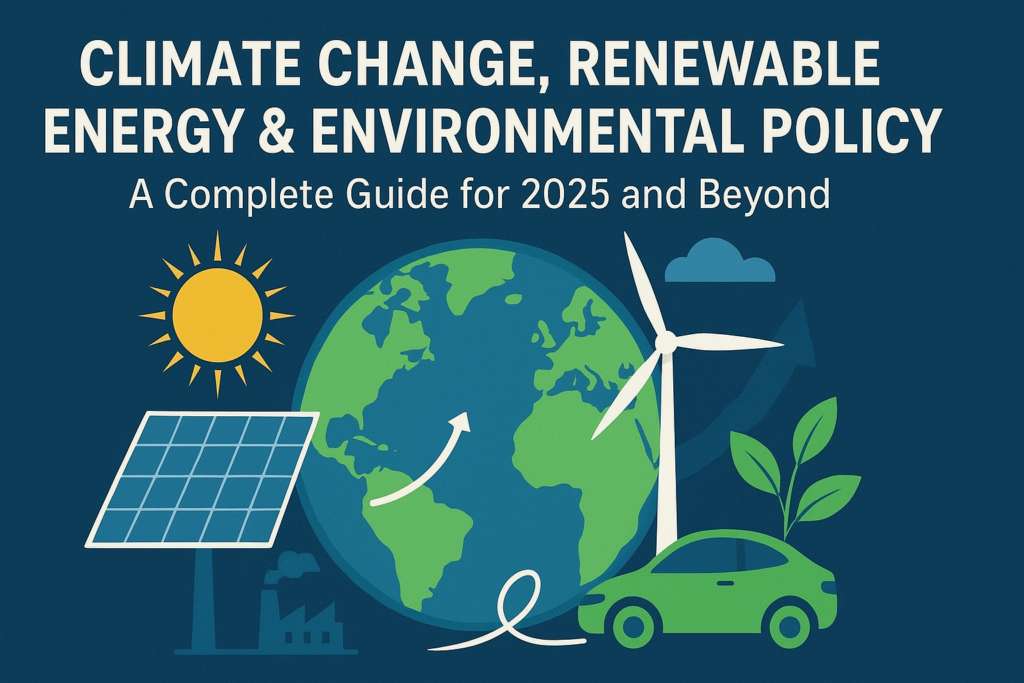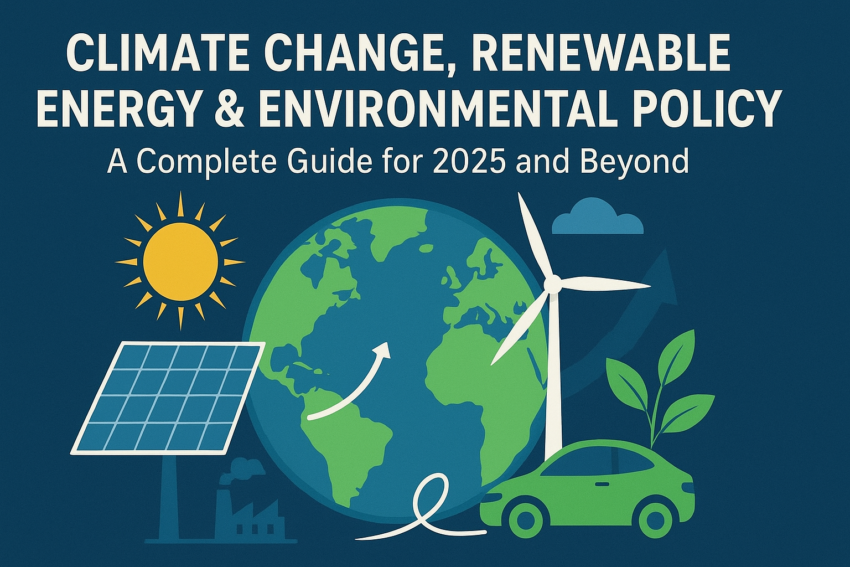Climate change is no longer a distant concern—it is a present-day reality affecting every corner of the world. Rising global temperatures, unpredictable weather patterns, melting glaciers, and increased natural disasters are clear reminders that urgent action is needed. At the heart of this fight against climate change lies renewable energy and strong environmental policies that can shape a sustainable future for generations to come.
In this blog, we will explore how climate change is reshaping the planet, why renewable energy is the key solution, and how environmental policies can drive positive change in 2025 and beyond.
Understanding Climate Change
Climate change refers to long-term shifts in temperature, precipitation, wind patterns, and other aspects of the Earth’s climate system. The primary driver of today’s climate crisis is the increase in greenhouse gases (GHGs) such as carbon dioxide (CO₂), methane (CH₄), and nitrous oxide (N₂O), which trap heat in the atmosphere.
🌡️ Key Impacts of Climate Change:
Rising global temperatures: The last decade was the hottest in recorded history.
Sea-level rise: Melting glaciers and ice caps threaten coastal cities.
Extreme weather events: Cyclones, droughts, and floods are becoming more frequent.
Agricultural disruption: Reduced crop yields, food insecurity, and water scarcity.
Biodiversity loss: Thousands of species face extinction due to habitat destruction.
⚡ Renewable Energy: The Game Changer
🌱 Major Types of Renewable Energy:
Solar Energy ☀️
Solar panels convert sunlight into electricity. India, with abundant sunshine, has become one of the fastest-growing solar markets in the world.
Wind Energy 🌬️
Wind turbines generate clean electricity with minimal environmental impact. Countries like Denmark and the U.S. are global leaders in wind power.
Hydropower 💧
Dams and rivers are used to produce electricity. While effective, hydropower must be balanced with ecosystem preservation.
Biomass Energy 🌾
Organic materials such as agricultural waste and forestry residues are converted into energy.
Geothermal Energy 🌋
Harnessing heat from beneath the Earth’s surface provides a constant and reliable energy supply.
🌍 Benefits of Renewable Energy:
Reduces greenhouse gas emissions.
Provides long-term energy security.
Creates millions of green jobs worldwide.
Encourages innovation in clean technology.
Reduces dependence on imported fossil fuels.
📜 The Role of Environmental Policy
While renewable energy technologies are essential, strong environmental policies are the real driving force behind large-scale adoption. Governments and international organizations play a crucial role in creating frameworks that encourage sustainability.
🏛️ Key Global Environmental Policies & Agreements:
The Paris Agreement (2015): Nations agreed to limit global warming to below 2°C above pre-industrial levels.
COP28 and COP29 (2023-2024): Focused on phasing out coal, scaling renewable energy, and financing climate-friendly projects.
National Renewable Energy Policies: Countries like India, Germany, and China have aggressive renewable targets for 2030 and 2050.
🌐 Why Environmental Policy Matters:
Provides regulations and incentives for industries to adopt clean energy.
Encourages carbon pricing & carbon credits, making polluters accountable.
Promotes research and development in green technologies.
Protects biodiversity and natural ecosystems.
🚀 Future of Climate Action: 2025 and Beyond
The future depends on how quickly governments, businesses, and individuals adopt sustainable practices. Here are the key trends shaping climate action in 2025 and beyond:
- Green Hydrogen Revolution
Green hydrogen, produced using renewable energy, is expected to power industries and transportation. - Net-Zero Commitments
Countries and corporations are pledging to reach net-zero emissions by 2050. - Climate Tech Startups
Innovative startups are creating AI-powered climate solutions, from carbon capture to smart farming. - Electric Vehicles (EVs)
EV adoption is accelerating worldwide, supported by government subsidies and charging infrastructure. - Global Youth Movements
Young activists are influencing policies and pushing for accountability in climate decisions.
💡 How Individuals Can Contribute
Climate change solutions are not limited to governments and corporations—individuals can make a huge difference:
- Switch to solar rooftops or energy-efficient appliances.
- Use public transport, cycling, or EVs instead of fossil-fuel vehicles.
- Reduce plastic usage and embrace zero-waste living.
- Support eco-friendly brands and local sustainable businesses.
- Spread awareness about climate literacy.
Also Read : How AI [Artificial Intelligence] Can Change Your Life: A Complete Guide
Table of Contents
🌍 Frequently Asked Questions (FAQs)
1. What is climate change and why is it important in 2025?
Answer: Climate change refers to long-term changes in global temperatures and weather patterns caused mainly by human activities like burning fossil fuels. In 2025, it’s more important than ever because global warming is accelerating, leading to extreme weather, sea-level rise, and biodiversity loss.
2. How can renewable energy help fight climate change?
Answer: Renewable energy sources like solar power, wind energy, and hydropower reduce greenhouse gas emissions, cut air pollution, and provide sustainable electricity. Shifting to clean energy in 2025 is a key solution to achieving net zero emissions.
3. What are the most popular renewable energy sources in 2025?
Answer: The top renewable energy sources in 2025 are solar energy, wind energy, hydropower, biomass, and green hydrogen. Among these, solar and wind power are experiencing the fastest growth globally.
4. What is the role of environmental policy in tackling climate change?
Answer: Environmental policies create laws, regulations, and incentives that encourage industries and individuals to adopt sustainable practices. Policies like the Paris Agreement and national renewable energy targets are driving global action to reduce carbon emissions.
5. How can individuals contribute to reducing climate change in 2025?
Answer: Individuals can switch to solar rooftops, use electric vehicles (EVs), adopt zero-waste lifestyles, reduce plastic use, and support eco-friendly brands. Small actions at scale can create a big impact on global sustainability.
6. What is the future of renewable energy beyond 2025?
Answer: The future of renewable energy includes the rise of green hydrogen, climate tech startups, and large-scale EV adoption. Countries are investing heavily in clean energy to meet their net zero 2050 goals.
7. Why is net zero 2050 important?
Answer: Net zero 2050 means reducing greenhouse gas emissions to nearly zero while offsetting the rest through technologies like carbon capture. Achieving this goal is crucial to prevent irreversible climate damage and ensure a sustainable future.

📝 Conclusion
Climate change is the defining challenge of our time, but it also presents an opportunity to build a cleaner, fairer, and more resilient future. By embracing renewable energy and enforcing effective environmental policies, the world can achieve sustainable growth while safeguarding our planet.
The year 2025 marks a turning point—either we take action now or risk irreversible damage. With collective efforts from governments, industries, and individuals, a green future powered by renewable energy is not just a dream, but an achievable reality.
